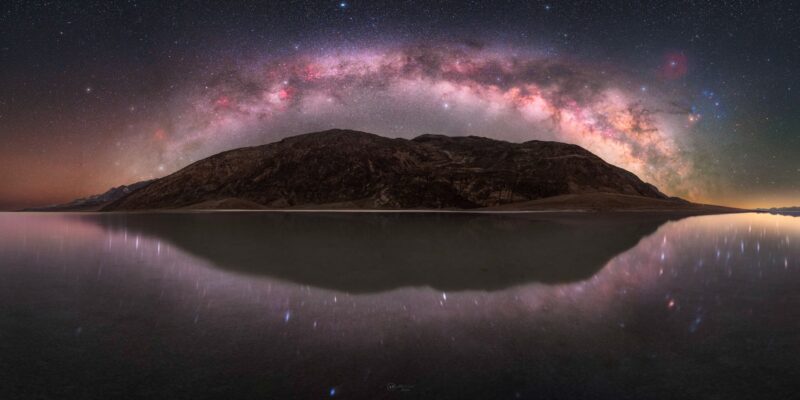
Heavy rainfall leads to wildflower blooms in Death Valley
As of April, 2024, temporary lake in Death Valley National Park at the Badwater Basin has receded quite a bit, but it’s still there. And recent rains have meant a profusion of wildflowers in bloom at the park. The Washington Post reported on April 13 that 2024 should be one of the best wildflower seasons in Death Valley since 2016. scientists estimate that tens of thousands of acres are blooming simultaneously. The Washington Post quoted Naomi Fraga, the director of conservation at the California Botanic Garden, the largest botanical garden dedicated to the state’s native plants, who said:
The casual visitor, in a time when there aren’t wildflowers, would think, ‘Oh, this is barren, this is desolate, no wonder they call it Death Valley — I don’t see the life. The thing about a superbloom is it forces you to realize the abundance of life that’s actually here. Because all of a sudden you have all these annuals that are everywhere and it’s amazing. It just feels magical, beautiful.
The Washington Post also called the current wildflower season a superbloom, although there isn’t a scientific definition of that term. The term superbloom became popular during the 2016 bloom season. While this year’s wildflower season isn’t as prolific as 2016, nor as plentiful as the state of California’s superbloom last year, the normally desolate park is seeing a blast of wildflowers.
The lake at Badwater Basin
The national park service said there are areas of “localized high concentration of blooming flowers.” Currently, the best places to view the wildflowers are in Panamint Valley and east of Furnace Creek. Learn more about the wildflowers in Death Valley and current conditions here.
Meanwhile, what is the status of the ephemeral lake at Badwater Basin, which showed up last summer? On April 10, 2024, the national park service for Death Valley said:
‘Lake Manly,’ the temporary shallow lake at Badwater Basin (formed after storms in August 2023 and February 2024) is evaporating. … We do not know how long the lake will be present, but as of mid-April, visitors can still see beautiful reflections of the mountains in the water.
Images from previous Death Valley superblooms
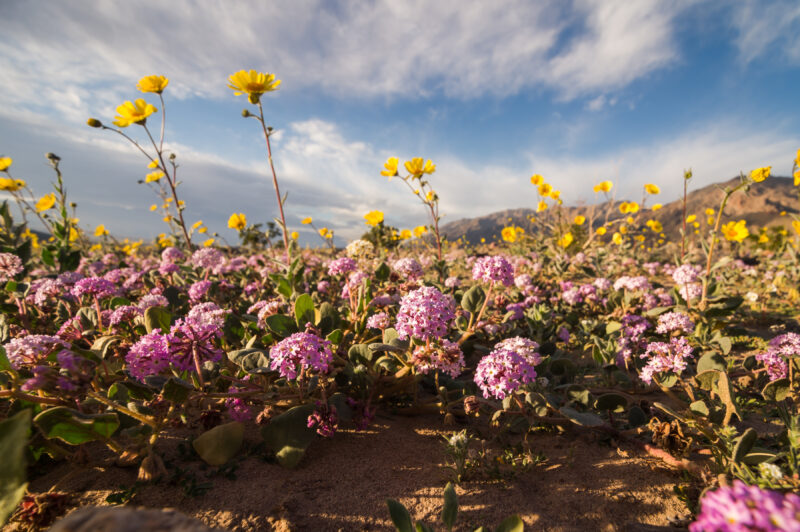
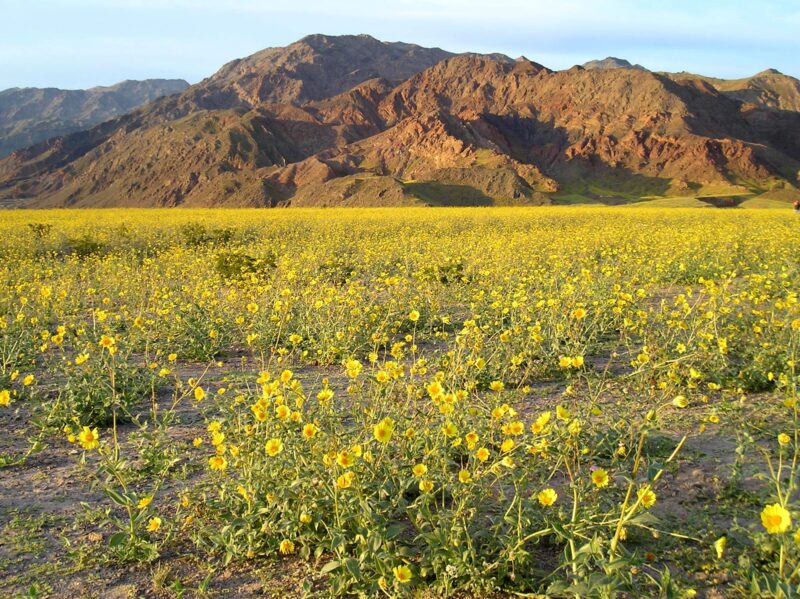
Below is the original story by Lindsey Doermann that NASA Earth Observatory published on February 16, 2024. Edits by EarthSky.
Death Valley lake is ephemeral
If you get a photo of the wildflowers at Death Valley, submit it to EarthSky!
Death Valley is the driest and hottest place in North America, and Badwater Basin is the lowest point in North America at 282 feet (86 m) below sea level. Still, a new lake formed at Badwater Basin in August 2023 in the aftermath of Hurricane Hilary. And, in April 2024, the lake in Badwater Basin is showing its staying power. The lake gradually shrank but persisted throughout the fall and winter. And then a potent atmospheric river filled it back up in February 2024.
Death Valley typically receives about two inches (51 millimeters) of rain per year. However, in the past six months alone, more than double that (4.9 inches or 125 mm) fell at the national park’s official weather gauge at Furnace Creek. Two events were responsible for most of that precipitation. The remnants of Hurricane Hilary delivered 2.2 inches on August 20, 2023. And then an atmospheric river brought another 1.5 inches (38 mm) from February 4 to 7, 2024, according to park officials.
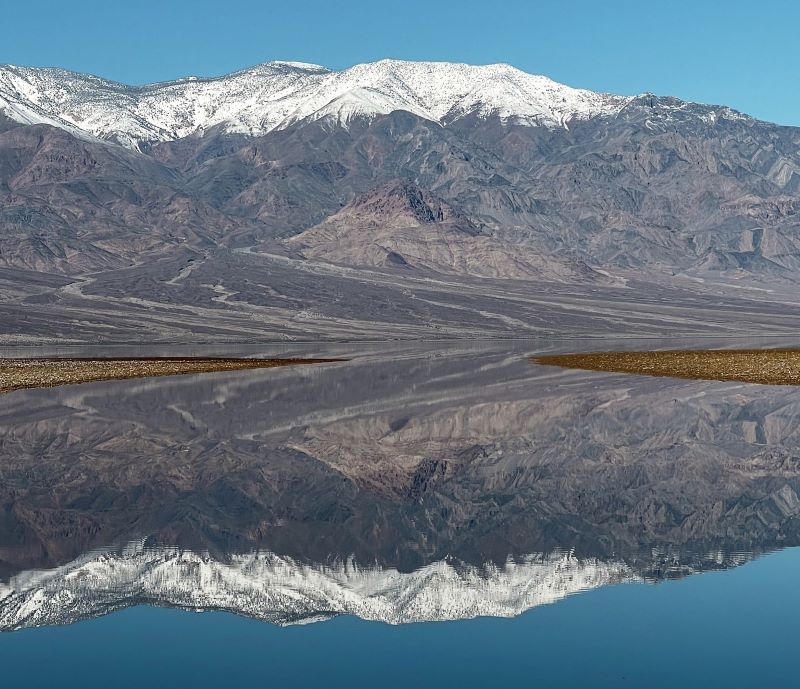
The lake has some staying power
Following the August deluge, Death Valley National Park ranger Abby Wines said in a news release:
Most of us thought the lake would be gone by October. We were shocked to see it still here after almost six months.
And that was before the rains returned in February.
After the early February atmospheric river moved through, observers on the ground saw the lake continue to expand as water drained into the area. On February 11, park ranger Matthew Lamar noted:
The Amargosa River [which feeds the basin from the south] is really flowing, and we’ve noticed the water level continue to rise over the last couple of days as waters make their way to the basin.
Badwater Basin is endorheic, meaning that water flows into but not out of it. Typically, evaporation far outpaces inputs, rendering the lake ephemeral. But in the past six months, the influxes have changed the equation.
Tracking the lake from above
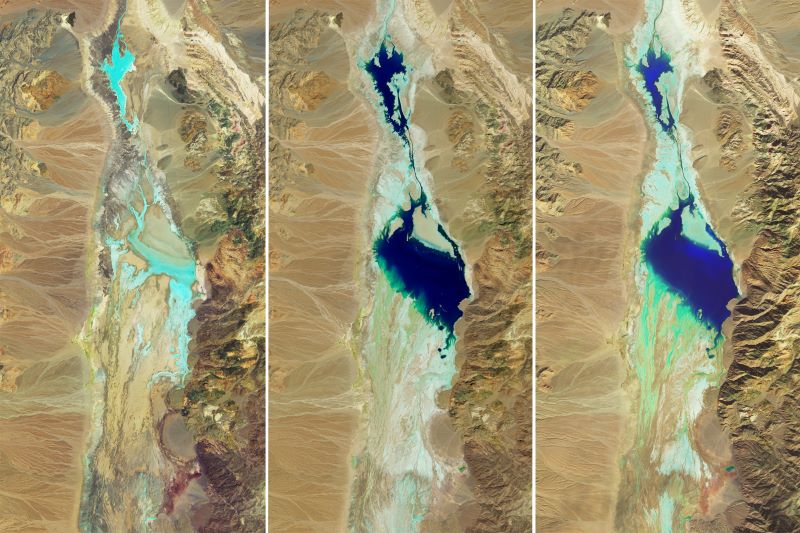
This series of images compares the desert basin before flooding (left) with its more-waterlogged state following each major storm. In both August 2023 (middle) and February 2024 (right), a shallow lake several kilometers across fills in the low-lying salt flat. The Operational Land Imager (OLI) sensor on Landsat 8 (left and right) and the OLI-2 on Landsat 9 (middle) took these false-color images.
Based on satellite imagery, the lake appears to have grown to a similar size in February 2024 as it did in August 2023, extending its months-long tenure. This comes as welcome news to visitors, who have enjoyed witnessing stunning reflections of the surrounding peaks in its calm waters.
As of February 14, the lake is one foot deep in places, according to park officials. And it’s uncertain how long it will last. Past appearances of the lake are rare and offer little insight into the current situation. When a lake formed in 2005, for example, it reportedly lasted about one week. It’s also too early to know how the precipitation will affect the wildflower season, which runs from late-February to mid-April, they said.
Images of new lake in Death Valley
Badwater Basin in Death Valley, tonight pic.twitter.com/XmF9OQ9WYN
— Cody Mayer (@CodyMayer22) February 14, 2024
Lake Manly fluctuated in extent during the Pleistocene along with many other pluvial lakes and active rivers in Mojave area of southern CA and NV. At its high stand Lake Manly was ~600 ft deep and 90 miles long (much larger than the current ephemeral lake) pic.twitter.com/AOHTU5md81
— Laura Cunningham (@PaleoLaura) February 20, 2024
Bottom line: The heavy rains in Death Valley National Park over the past six months created a temporary lake and now a profusion of wildflowers.











